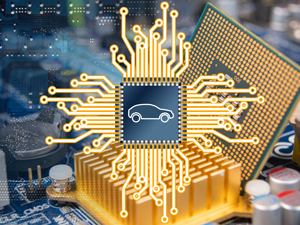With so much going on, from supply chain disruptions to decision-making from beyond our border, employee priority shifts and more, 2022 will be an important year to keep a watchful eye on global developments.

With the end of the year rapidly approaching, it’s time to take stock of what was accomplished and look through the windshield to where we could be headed. This year has been unremarkable in many ways, with many of us anxious to put 2021 in the rear-view mirror. In other ways, it was a strong year for getting things done, clearing the decks, and reorganizing.
Automotive retail has always had shifting tides, to one degree or another, but none as shifty as this past year across so many fronts. The entire global industry value chain has been tampered with, link by link. Nothing was sacred and everything was on the table.
Look for more of this in the years to come, as all the pieces that make up our wonderful industry get shuffled around, replaced, or reinvented.
Our little domestic market here in Canada normally shows more signs of local decisions than global ones. During 2021, decision-making from beyond our borders increased in scope and reach. Canada is rapidly becoming a test bed for new initiatives not unlike Australia, Norway, and other relatively small markets.
Experiments will continue to run and results analyzed and shared with global decisions being made from far off lands.
Don’t get me wrong, it’s not doom and gloom. This could very well be the new path to Canadian prosperity and meaningful global contribution. Never has observing and being connected to the global industry been so important as it is today.
It’s our opportunity to gain view through various windows to see what could be coming in our direction. It gives us the time to prepare, analyze, and understand. It also gives us the opportunity to show our metal and offer leadership to the rest of the world.
The 2020-2021 year will be forever remembered as the COVID year where health and safety concerns dominated, as did government control over the population at large while businesses of all shapes and sizes had to take a back seat and adopt strict protocols to protect employees and customers. This meant that many businesses had to shut down, take a break, and take baby steps to reopen without sufficient cash flows from customers to guarantee survival.
Many did not make it.
On the positive side, it also reinforced that the automotive industry in its entirety is essential and needs to remain strong and open, even in desperate times.
This year will also be known for the chip shortage and other supply chain disruptions that collapsed new vehicle inventories on dealer lots and dampened sales. In addition, 2021 saw the beginning of the crystallization of electric vehicles, as new brands and models seriously moved from concept to reality.
Looking ahead to 2022, there is much on the horizon to keep our eyes on. For the first time in more than a decade, inflation will be back with a vengeance.
We are already seeing signs that everything is becoming more expensive, even as the world reopens, and many aspects of life return to a new normal. Inflation is being caused by fundamental changes in the global and domestic economy, but also by opportunity.
This year, we saw the rapid increase of some key items like lumber, but we also saw decreases in certain items like gasoline, as demand dwindled with most everyone staying home. Now all prices seem to be on an upward trajectory. This means that we will see interest rate hikes in the short-term, as central banks use their monetary policy to keep the rate of inflation in check.
For dealers, this spells higher interest costs on all floating debt for the foreseeable future, and the end to extremely low-cost financing.
There also is a fundamental shift in how employees work.
Many companies are adopting a whole range of workforce options, many of which will reduce commuting and business travel. As a result of spending so much time at home, employees have evolved and amended some of their core values.
For example, working parents of preschool aged children stayed home for many months. Many two-income families now realize the true costs of working outside the home and are deciding to choose different alternatives, at least in the short-term.

February 1st 2020: Electric Rivian truck on display in Austin, Texas.
Another example are the road warriors—those employees that left home on Sunday evening not to return until Friday, week-in and week-out. Many have learnt from the virtual meetings of the past 20 months and are not too keen to return to their previous travel pace.
Currently, business travel bookings are roughly half of what they were in 2019. However, leisure travel bookings are running ahead of 2019 levels. It’s early days, but one could conclude that it’s not the travel itself, but the reason for travel and use of productive alternatives that has shifted.
Next year, 2022, will see the continued barrage of electrified vehicles as our industry begins to escalate its charge to compliance with short-term and medium-term self-imposed and government mandated targets.
The year 2025 is only three years away. New entrants, like Rivian and Lucid for example, are starting Canadian operations with many more new entrants on their way. Tesla is entering its next phase in Canada by opening standalone facilities. Add the new entrants to already announced electrification efforts of traditional automakers, and this relatively small market segment quickly becomes overcrowded.
Another thing—2022 will also see the rapid development of vehicle charging infrastructure for the likes of Autochargers, EVduty, Sparkev, Electrify Canada, Grizzle-E, ChargePoint, and many others on the road to making every garage, parking lot, truck stop, and gas station in Canada a charging location.
Concerns about the capability and capacity of our electrical grid aside, 2022 will see an explosive increase in vehicle charging infrastructure.
Global turf wars will continue to play havoc with our supply chain in 2022, led by the superpowers of China and the United States, and affecting most countries—Canada included.
This is leading to a reversal of globalization initiatives of the past 30 years, as countries began the long journey to develop and support domestic production of critical goods and services. As the political landscape shifts globally, it’s anyone’s guess where this will end up.
I also want to mention the escalating role of digitalization in the automotive industry and the rise in importance of capture, maintenance, protection, and use of data.
The new vehicles being built today all have some degree of increasing connectivity—be it in our service bay plug-ins or over-the-air updates. Vehicles have the potential to produce so much data that managing it all is quite overwhelming. Coupled with the rapidly increasing trend in digital retailing, this is a foundation for automotive companies to reinvent themselves from top to bottom.
Many believe this could be their opportunity to develop into technology companies from their traditional position as manufacturing companies, and thus be viewed differently by financial markets.
Tesla, for example, is a technology company that happens to produce vehicles. Its valuation is in a stratosphere that automotive companies can only dream of. In fact, some companies that are yet to produce a production version of their new vehicles have a value greater than some household name OEMs that have been around for years.
Most traditional vehicle companies want to get a piece of the increased shareholder value perceived to be there for the taking, but the transition is encountering numerous potholes and bumps along the way. They will get this right, in one form or another, but in the meantime, the experiments will continue.
In the meantime, we must all keep a watchful eye on global developments to analyze how the moving of parts and pieces might affect us all.











